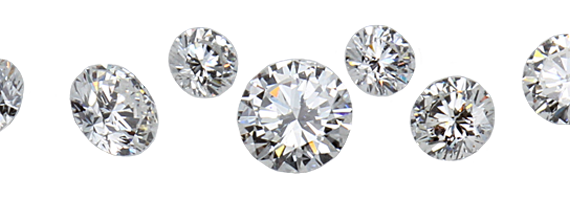
Diamond is natural gemstone, which is formed in very high pressure and temperature conditions.
Diamond is supposed to be the hardest known natural substance, which is broadly used in industry as well as in jewelry.
Diamonds become a girl’s best friend only after careful handling of lapidary.
As diamonds are natural origin, there are no two the same kind. Therefore it is developed methodology for characterization and qualification of diamonds.
The methodology is based on 4 criteria, known as 4Cs:
Diamond color;
Diamond clarity;
Diamond carat;
Diamond cut.
One and most important factor, which affects value of the diamond, is its rarity, so the better condition of surface (absence of imperfections on surfaces or in the stone) and structure, the more perfect diamond you own.
Diamond color
The most valuable diamonds are colorless, but never the less they can occur also in diverse colors. The diamonds can be divided in two groups- traditional colors and fancy colors. Traditional colors, which are majority, are in range of pale yellow or brown in different tonalities. Fancy colors are all the rest for example steel gray, blue, orange, red, green, white, pink, purple or black. Different diamond colors were formed depending on the chemical composition and inclusions in the crystal lattice.
|
G.I.A. |
C.I.B.J.O. |
I.D.C./H.R.D. |
U.K. |
SCAN.D.N. (до 0,5 карат) |
SCAN.D.N. (0,5 карат и выше) |
|
D |
Blanc cxeptionnel + |
Exeptional white + |
Finest white |
Rarest white |
River |
|
E |
Blanc cxeptionnel |
Exeptional white |
|||
|
F |
Extra blanc + |
Rare white + |
Fine white |
Rare white |
Top Wesscllon |
|
G |
Extra blanc |
Rare white |
|||
|
H |
Blanc |
White |
White |
White |
Wesselton |
|
I |
Blanc nuance |
Slightly tinted white |
Commercial white |
Slightly tinted white |
Top crystal |
|
J |
Top silver Cape |
Crystal |
|||
|
K |
Blanc legerement teinte |
Tinted white |
Silver Cape |
Tinted White |
Top Cape |
|
L |
|||||
|
M |
Teinte |
Tinted |
Light Cape |
Slightly yellowish |
Cape |
|
N |
|||||
|
O |
Cape |
Yellowish |
|||
|
P |
|||||
|
Q |
|||||
|
R |
|||||
|
S-Z |
Dark Cape |

Diamond clarity
Naturally formed diamonds have inclusions and surface irregularities, which make them unique and help jeweler to recognize them from each other and from false ones. This is a bright side of the clarity. The dark side of the clarity is that it has great impact on value of diamond. As diamonds with lack of inclusions or surface irregularities are rarity, they also set the top prices.
Table of international standarts
|
G.I.A. |
C.I.B.J.O. |
SCAN.D.N. |
|
Flawless |
Flawless |
Flawless |
|
IF |
- |
IF |
|
VVS1 |
VVS1 |
VVS1 |
|
VS1 |
VS1 |
VS1 |
|
SI1 |
SI |
SI1 |
|
I1 |
P1 |
P1 |
|
I2 |
P2 |
P2 |
|
I3 |
P3 |
P3 |
Diamond carat
Weight of diamond is defined as carat, which equals 0,2 grams. Carat has been used as a unit of measurement for centuries. The name has first time attested in the middle ages. It comes from Italian word “carato” meaning carob seed. They used carob seeds for measurement of weight, because they assumed that the seed had low variability in mass. So they could control the price and set criteria for gemstones.
The smallest unit of carat is 0,01 carat, but the largest is 100 carat.
There is division of diamonds according it weight and diameter:
Weight 0,03 ct =diameter 2,0 mm
Weight 0,10 ct =diameter 3,0 mm
Weight 0,30 ct =diameter 4,3 mm
Weight 1,00 ct=diameter 6,5 mm
Weight 1,50 ct =diameter 7,5mm
Weight 2,00 ct =diameter 8,2 mm
Weight 3,00 ct =diameter 9,4
The overall trend:
Small sized diamonds until 0,29 ct;
Average sized diamonds from 0,30 ct until 0,99 ct;
Big sized diamonds from 1,00 ct and more.
Elements of a brilliant

Diamond cut
The diamonds are processed to highlight their natural beauty. The quality of cut is precondition for sparkling and fizzy games of light in gemstone. Diamond cut refers to a style or guide used when shaping a gemstone for polishing.
Most common shape is round brilliant, whose facet proportions and arrangements have been worked out perfectly - with 57 edges. They makes gemstone to sparkle the most, but still You can find a different cut forms, such as oval, marquise, pear, heart, princess and emerald. Choice of shape depends on several factors- shape and size of crystal.

Certificates of Diamonds
Diamonds can be evaluated in global market in more than one institution. The most important ones worldwide are Gemological Institute of America (GIA), European Gemological laboratory, International Gemological Institute (I.G.I), The Scandinavian diamond nomenclature (SCAN.D.N) or HRD Antwerp located in Netherlands.
All provided gems by our company are certified in Assay Office of Latvia. We assure authenticity of every single jewel we sell.
We provide possibility to obtain extra certification for particular jewel from GIA, if the gemstone is bigger than 0.3 carat.
